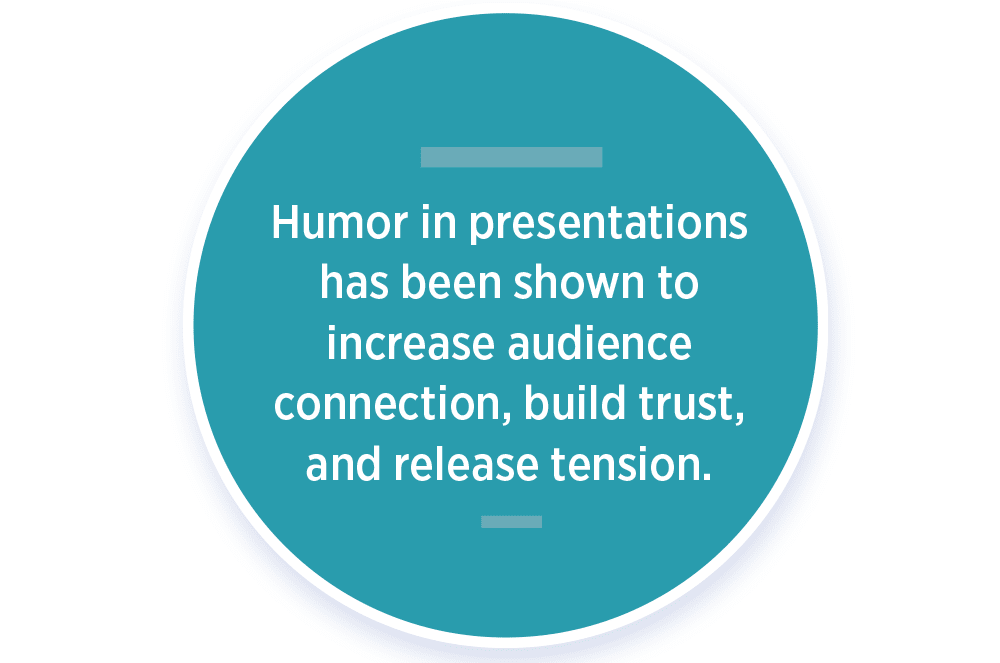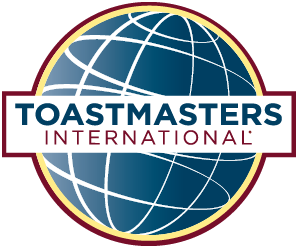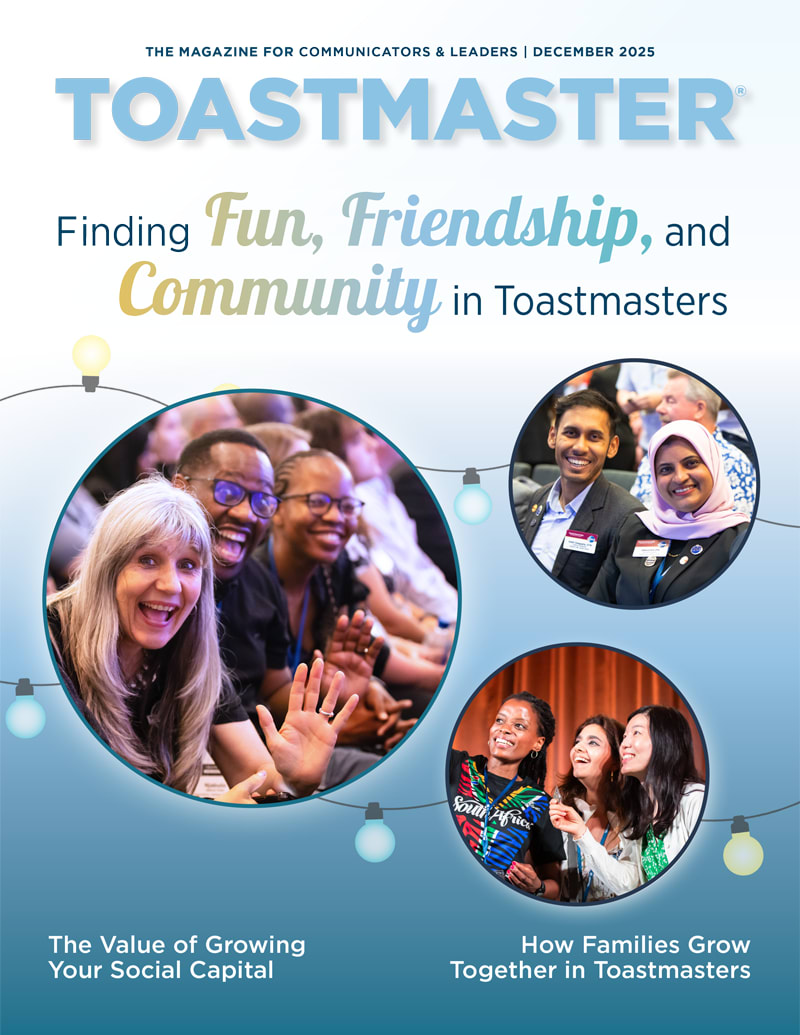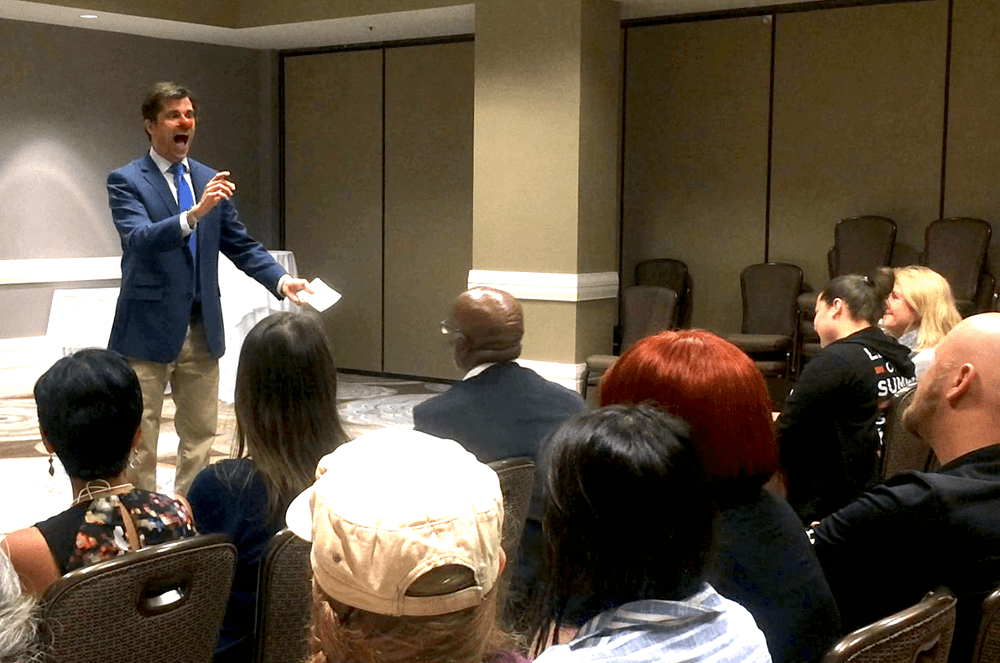
Imagine you’re standing at the front of your office conference room. Your team, your manager, and a member of your company’s executive leadership team sit before you in the audience. You’re presenting a status update, and midway through, you attempt a joke. You’re greeted with … silence. Oof!
Okay, you can snap out of your nightmare now. Using humor in work presentations can be a delicate balancing act. We’ve all known folks at work who joke too much, and we’ve all known folks at work who don’t seem to understand the concept of humor. I’ve been guilty at both ends of the spectrum. However, after two decades as a corporate facilitator and professional speaker for Fortune 500 companies around the world, I’ve learned that workplace humor can be incredibly effective if used skillfully.
Perhaps you avoid using humor in work presentations because you worry that incorporating it will reduce your credibility with your peers and superiors. However, humor in presentations has been shown to increase audience connection, build trust, and release tension.
For classical rhetoric fans out there (you know who you are), Aristotle defined the three tools of persuasion as ethos (character), logos (logic), and pathos (emotion). Humor at work falls under ethos, because eliciting workplace-appropriate laughs can show your audience that your character is similar to theirs and you understand their point of view. This feeling of similarity increases your chances for persuasion and influence (according to good old Aristotle, anyway!).
Humor can help you flourish in your career, as well. A frequently cited survey by Hodge-Cronin & Associates found that 84% of managers say that a sense of humor correlates with better work, and 98% prefer to have people with a sense of humor working for them.
So how can you embrace this humor superpower in your next business presentation to enhance trust, build connection, and maybe even get yourself a raise? Try these three tactics:
- Own It
Many stand-up comics begin their sets making fun of their own obvious quirks and eccentricities. You can leverage this tactic as well in your work presentations. Making light of yourself serves two purposes: It shows your audience you’re already aware of what they might be thinking of you, and, since we all have quirks and eccentricities, it shows that you’re one of them (a fellow member of the human race). These two elements set your audience up to be more receptive to your message.
How to do it:
Start by writing down 10 things that would be immediately obvious and unique about you to your particular audience. A useful (but scary) question you can ask yourself is, What do people make fun of behind my back? Perhaps you’re known around the office as a bit of a stickler for the rules. You could say, “You may think of me as a pretty by-the-book guy, but I can get a little crazy sometimes. In fact, just last night, I drank a glass of milk that was one entire day past its expiration date!”If you can poke fun at yourself, you show your audience that you embody the self-esteem and executive presence required to take yourself lightly, and maybe even get a laugh out of the deal. A caveat here, however: While making fun of your personal quirks can be very effective, never make fun of your message or your subject matter expertise, or you risk undermining your presentation.
Another way to own it is by delivering what is known as a “dad joke,” which is typically a pun or an inoffensive, corny joke that a goofy father might say to embarrass his kids. For example, when I speak at cybersecurity tech conferences, I sometimes use this dad joke to connect with my audience: "Why couldn’t the government catch the hacker? Because he ran-some-where. (Get it? Ransomware?)" A groaner like this is clearly not intended to elicit an authentic laugh from your audience due to the actual content. Instead, dad jokes like this receive giggles because you show you’re willing to be the focus of the laughter for a moment as the “bad joke teller.” It doesn’t affect your credibility with your content, it just shows that you’re confident and comfortable enough to connect with your audience by having some fun at your own expense.
- Hack It
“Hack” is a derogatory stand-up comedy term for overused and cliché topics or comedians. In stand-up, you absolutely don’t want to be labeled a hack or do hack material. But when it comes to work presentations, leveraging familiar, shared experiences can be a safe and effective way to utilize humor.As with all good presentations, the first step is always knowing your audience well. Carefully research your meeting attendees’ priorities, problems, and long-term objectives, and then drill down to find experiences or frustrations that you share. Leveraging this shared background for laughter is called “affiliative humor,” which celebrates inclusivity and connection.
But do your research carefully. Treating a seemingly shared subject lightly can backfire if some audience members have had a different or even traumatic experience with the topic, or aren’t aware of it. You can risk appearing tone-deaf or not reading the room. For example, I originally included a joke about Chuck E. Cheese, an American children’s restaurant, in my education session at the Toastmasters 2023 International Convention. Luckily, constructive feedback during rehearsals helped me realize that many of the international attendees would not get the reference, so I cut the joke. However, the well-considered, lighthearted reference to a shared, low-stakes frustration can be an effective way to prime your audience to embrace your message.
How to do it:
Before your next work presentation, jot down five low-stakes frustrations that you’re sure you share with everyone in your audience, like parking, traffic, or travel. Pick the most innocent, lighthearted frustration and mention it as you begin your talk.For example, when I’m speaking at conferences at the sprawling Mandalay Bay Convention Center in Las Vegas, I can garner an easy, familiar laugh from my audience by referencing shared Vegas annoyances, like the endless lunch lines at the Mandalay Bay food court, the long walks from the hotel to the conference center, and, of course, that wicked Vegas heat.
While you won’t necessarily garner a room full of belly laughs, you will bring about smiles and nods of recognition from your audience, and that recognition of familiarity was the goal all along.
- Personalize It
Particularly long or data-dense presentations pose a special challenge in keeping your audience engaged. Luckily, some strategic humor can give your audience a break from your information overload, allow them to reengage with you as a presenter, and provide a much-needed laugh for everyone.One tactic that works particularly well in such grueling yet necessary data marathons is the “calculated personal digression.” In one data-heavy software presentation I observed, the savvy speaker had planted a photo of his two cats in his PowerPoint deck during a transition between his presentation points. He feigned surprise (poorly), quickly introduced us to his cats, shared how they helped him with his presentation, and then went on with his talk. With this calculated personal digression, the presenter provided his audience a quick diversion from his data and gave everyone a reason to smile (unless they were dog people, of course).
How to do it:
Dropping a cute photo of your pets or kids into your data-dense slide deck seems simple enough, but the trick with the calculated personal digression is brevity. Explain your photo with three short sentences at most and then briskly continue on with your talk. You want to give your audience a playful data break, not an extended personal monologue. They will appreciate the moment of levity, and it may even be the most memorable part of your talk.


Let’s return to that imaginary scenario where we first began, with you standing at the front of your office conference room facing your team, your manager, and your executive leadership. But this time, you’re enjoying smiles, nods, and maybe even some laughs, because you’ve just employed one of these humor tactics in your status update presentation.
Now, make that scenario real. Incorporate some solid humor strategies into your next work presentation, and your audience (and maybe even your boss) will thank you for it!
Don Colliver is a corporate trainer, trade show presenter, and bestselling author living in the San Francisco Bay Area of California. He teaches teams to communicate more effectively so they can exceed their goals. Reach him at doncolliver.com.



 Previous
Previous

 Previous Article
Previous Article

